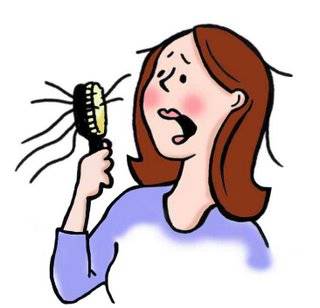It is common for men to lose their hair with age, and sometimes this process begins as early as the teenage years. Some men just accept it, while others seek treatment. When women develop thinning hair or baldness, it is often a source of great concern and anxiety for them. Androgenetic alopecia is a common cause of hair loss, but there are many others to consider, too.

1. Normal variation.
A hair’s natural cycle is for it to grow for several years, then fall out and be replaced. This means that at any given time, some hairs are always in the process of falling out while others are starting to grow in. Thus, it is completely normal to notice hair coming out with combing, brushing, shampooing, toweling or otherwise rubbing the scalp.
Sometimes this natural hair loss may temporarily exceed new growth, which may cause undue alarm about possible baldness. One of the first questions I ask patients concerned about hair loss is whether their hair is truly getting thinner, or are they just noticing more normal shedding than usual. The latter situation may not require any treatment at all.
2. Hormonal abnormalities.
A variety of hormonal problems are known to contribute to hair loss. Too much or too little thyroid hormone is a common cause of generalized thinning or loss of scalp hair. This is usually easily diagnosed with a simple blood test. Elevated testosterone tends to cause loss of scalp hair and promote growth of facial and body hair. High levels of insulin, often found in people with diabetes, can also cause hair loss. In women with polycystic ovary syndrome, there are elevations of both testosterone and insulin.
3. Scalp inflammation.
Several inflammatory skin conditions, such as eczema, seborrhea, and psoriasis, cause patches of hair loss with red and scaly skin underneath. Fungal scalp infections (also called ringworm) and bacterial infections of the hair roots (folliculitis) can also cause similar problems. Patches of hair loss without underlying redness may be due to an autoimmune condition called alopecia areata.
4. Local trauma.
Tight hairbands or cornrows can cause thinning simply by breaking off the hairs at their base. Some chemical hair treatments damage the follicles or the hair itself. Insects that attack the hair (like lice or scabies) can cause hair loss either by directly breaking the hair or by causing the person to scratch, which in turn damages the hair. Trichotillomania is a psychological condition in which people compulsively pull out or twirl their hair around a finger, sometimes without even realizing they are doing it, resulting in areas of broken-off hairs.
5. Medications.
Several medications can contribute to hair loss. Steroids and chemotherapy are among the most common culprits. Some diuretics (like sprinolactone) decrease levels of testosterone, and can reduce body hair, but usually don’t have much effect on scalp hair. (Editor’s note: this version corrects previous sentence, adding “decrease” and deleting “increase.”) If your hair loss seems to correspond to when you started a new medicine (or increased the dose), it’s worth checking with your doctor about a possible connection.
6. Psychologic factors.
Stress, anxiety, and depression are surprisingly common causes of thinning scalp hair, and can be especially difficult to recognize and treat. Many people don’t realize how much stress or anxiety they are actually experiencing, and so will tend to minimize their level of stress when considering possible causes of hair loss. The anxiety is then compounded by the hair loss itself, so the problem becomes even worse. Some people develop an escalating cycle of anxiety, worsening thinning of the hair, and increasing worry about hair loss.
Once you have noticed that you are losing your hair, the first step is to get a medical evaluation to determine the cause. Either your primary care physician (family practitioner, internist, pediatrician, or gynecologist) or a dermatologist is a good place to start. Treatment can then be directed to any of the above underlying causes that are present.
If such treatment is not sufficient, or if no identifiable cause can be identified, there are currently two medications that you might consider. Minoxidil (Rogaine®) is a topical treatment available over the counter. Its exact mechanism of action is not clearly understood but it can be safely used by both men and women. Finasteride (Propecia®), an oral medicine available only by prescription, works by preventing testosterone from transforming into its most active form, thereby reducing one of the major factors in male pattern baldness. Finasteride is not approved for use by women or children.
Both minoxidil and finasteride seem to be better at maintaining one’s current hair and reducing future loss than they are at regrowing new hair, but these meds may produce some new hair. Typically, these medications need to be used for 3 to 6 months before much benefit is seen, and, unfortunately, any improvement in hair growth will only last as long as the medicine is continued. If it is stopped, the hair loss tends to recur.
Many cosmetic approaches are also available. Wigs, hair transplants, hair weaves, and similar treatments can all hide an embarrassing or frustrating problem. If you’re not too fixated on growing your own natural hair, these can be easier and sometimes even less expensive in the long run than chronic use of medications.

